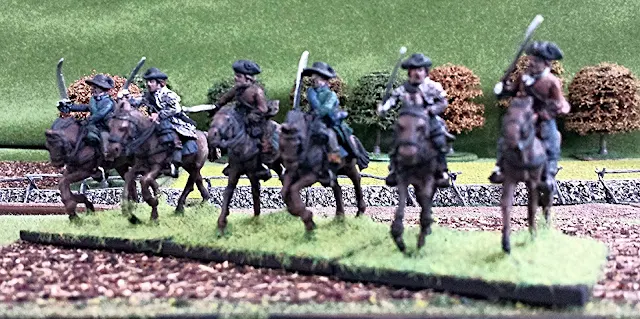The 2nd Partisan Corp or as it's better known as Lee's Legion was formed in April 1778 when it was detached from the 1st Continental Light Dragoons. Through its commander, "Light Horse" Harry Lee and his memoir the Legion's service is one of the better known regiments during the American Revolution. As to if it was an elite unit, that is up to the reader to decide. But what is not debatable is it could be, at times as ruthless as the British Legion with whom it fought. It was a very active part of Greene's army so I had to include it in my collection.
Incidentally, Lee's memoir was written partly to adress the controversy over Lee's action at Eutaw Springs. His son, Robert E. Lee would continue the defense of his father in later editions of the book.
There are numerous interpretations of how the Legion looked. This could be because the uniform was changed during the War and also supply problems. In addition different infantry elements were assigned to the Legion during its history. I have of course focused on it activities in 1781.
I understand that suggesting Lee's Legion were not dressed in green might go against current excepted knowledge this is usually suggested that Lee ambushed Pyle's loyalists because they were dressed similar to Targets 's British Legion. When I painted them up I used the painting of Lee himself in a tan/brown faced green coat. In addition I also used the following quote from private Shaw of the 33rd regiment of foot. He was captured just prior to guilford courthouse and wrote later:
"Scarcely had we gone half way up the lane, when seven of Lee's light horse made their appearance: my companion swore there was Tarleton's light horse coming, and, says he, ‘we shall be taken up on suspicion of plundering, and get 500 lashes a piece.' ‘No;' said I, upon observing their brown coats, and white cockades, ‘no, friend, you are deceived; these must be the rebels.' Having therefore discovered his mistake, he began to cry;--but for my part, I thought it very good fortune.—As they were advancing towards us, we concluded to go and meet them; which we accordingly did, and falling on our knees begged for quarter; which they granted ….
While the evidence, and most authorities agree on the inform of the Legion cavalry the Infantry are much more of an mystery. I think the evidence suggests the Legion infantry had a different uniform from the mounted element. There was an issue of enough cloth to three officers to make coats of blue faced red and lined white (see p40 Katcher Uniforms of the Continental Army). This was by the clothier general of Maryland in 1782. Coincidentally it was at the same time the portrait of Harry Lee
painted by Charles Wilson Peale. There is also a portrait of an officer of the Legion Infantry, Laurence Manning who was
shown in a blue coat faced red.
So I feel confident the Infantry element of the legion in 1781 at least we're in standard blue faced red coats. There is no evidence helmets were issued so I outfitted my infantry in standard infantry uniform.
For my table top Legion I have once again used the most excellent figures from Fife and Drum miniatures. While they do not make a figures for the Legion figures in their existing range work well. The cavalry comes from the 16th light dragoons. Minor filing was all the work they needed. For the Infantry I am using existing painted figures. Half of the Light battalion are used as Kirkwood's Delaware company, so the other half of the battalion are now the Infantry of the legion. Thus I get double duty out of that group. No flag for the unit. Although some sources suggest one I am unsure of the documentation. If better information comes available later to convince me I will add it then. And now I look forward to Lee tangling with Tarleton in the battle of the legions on my table top!

















